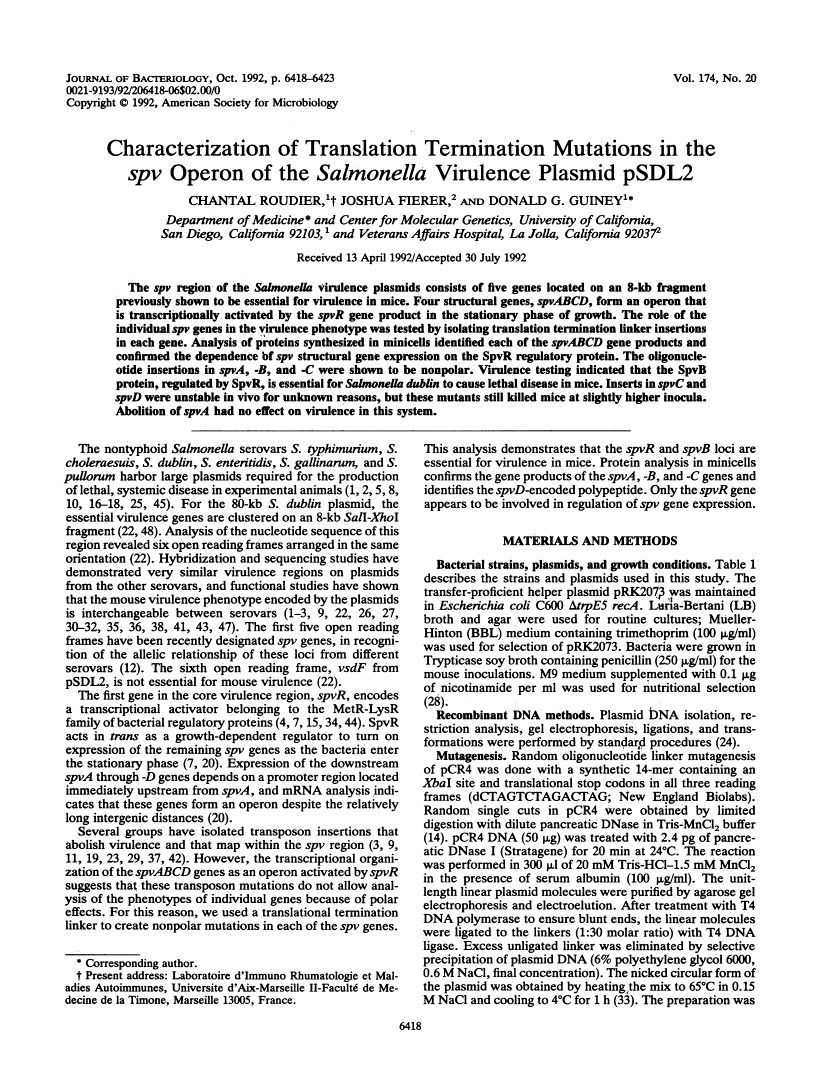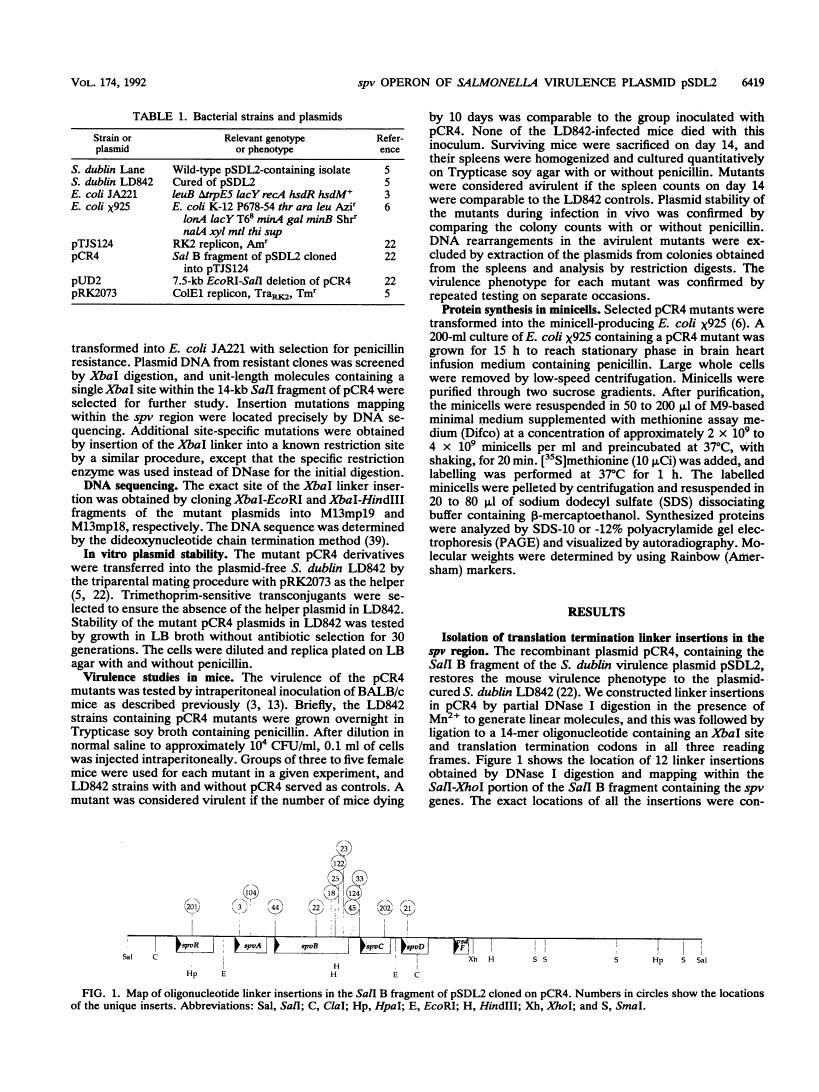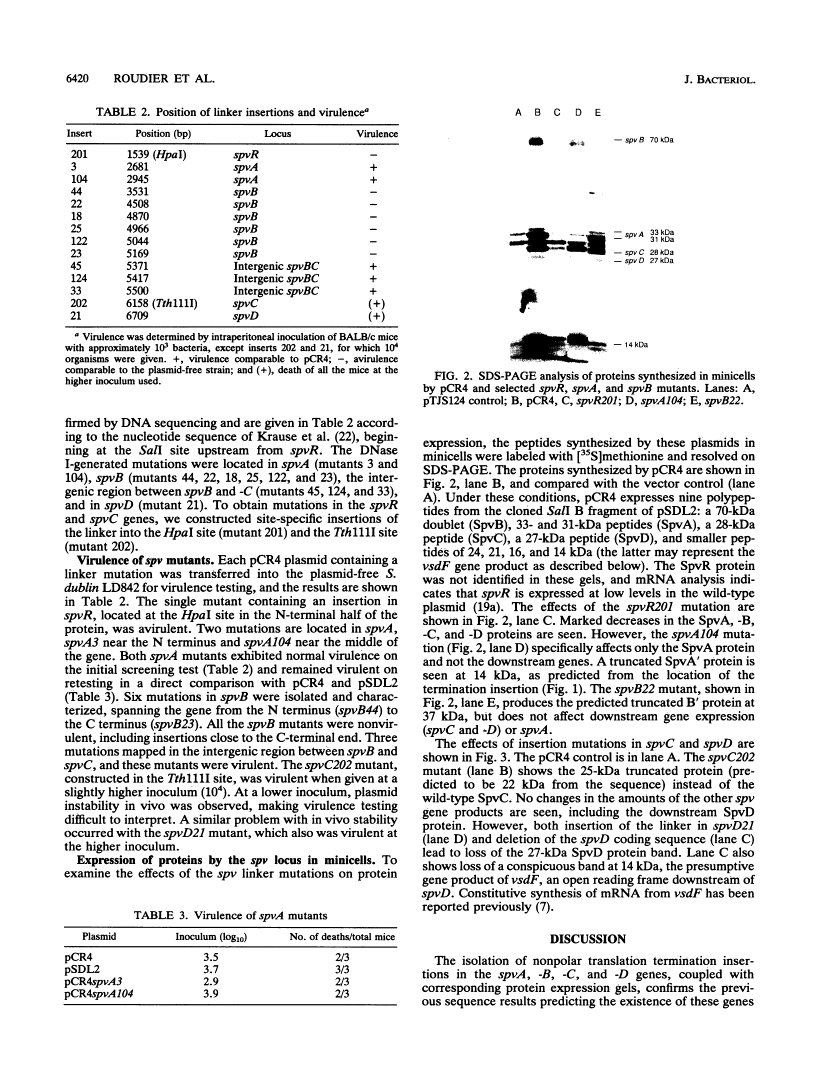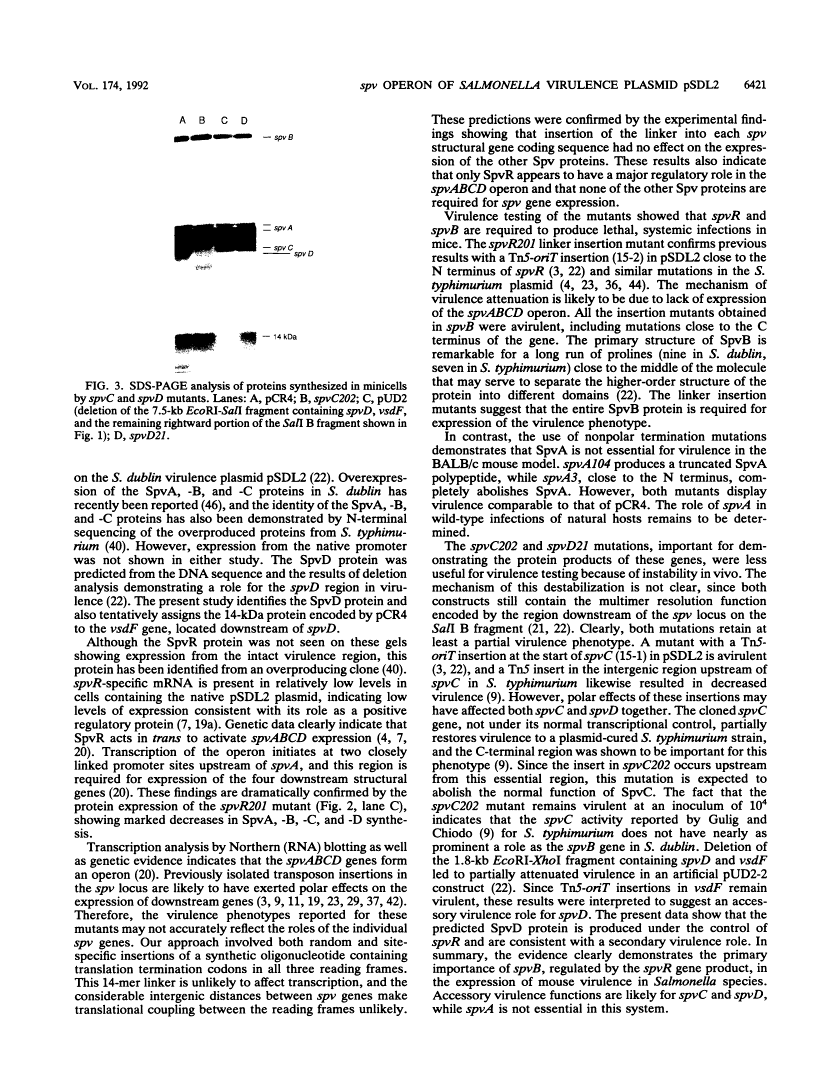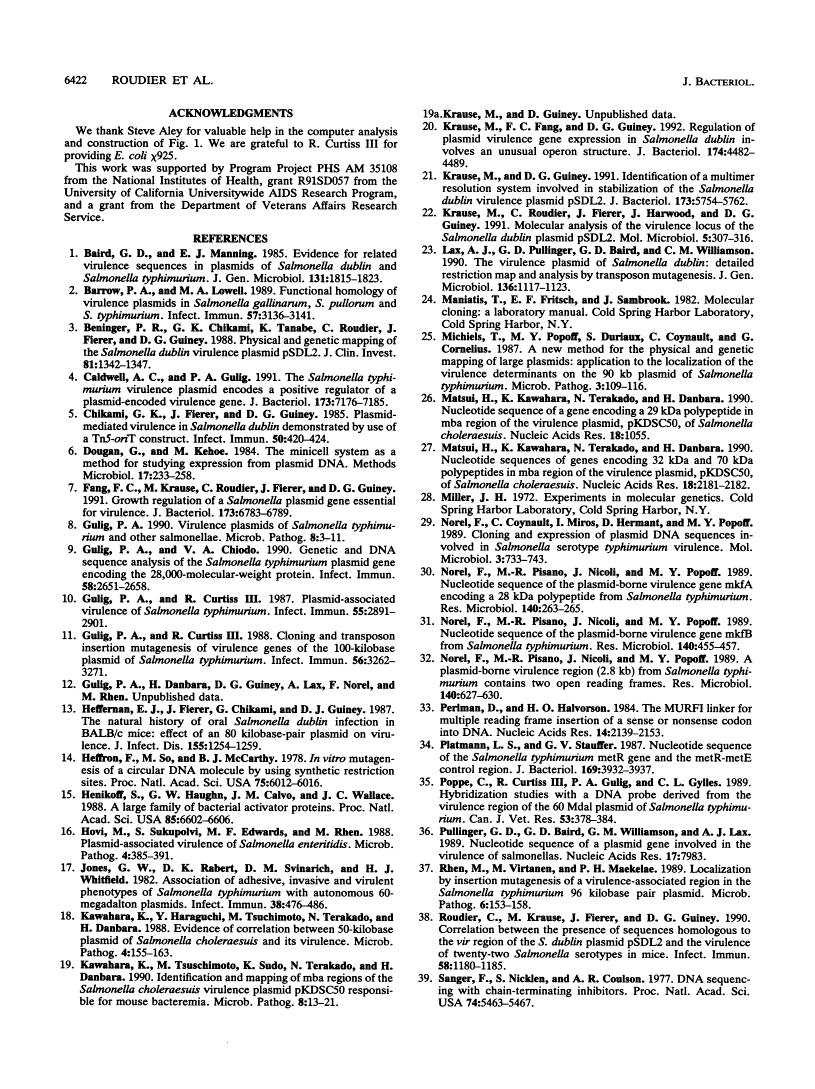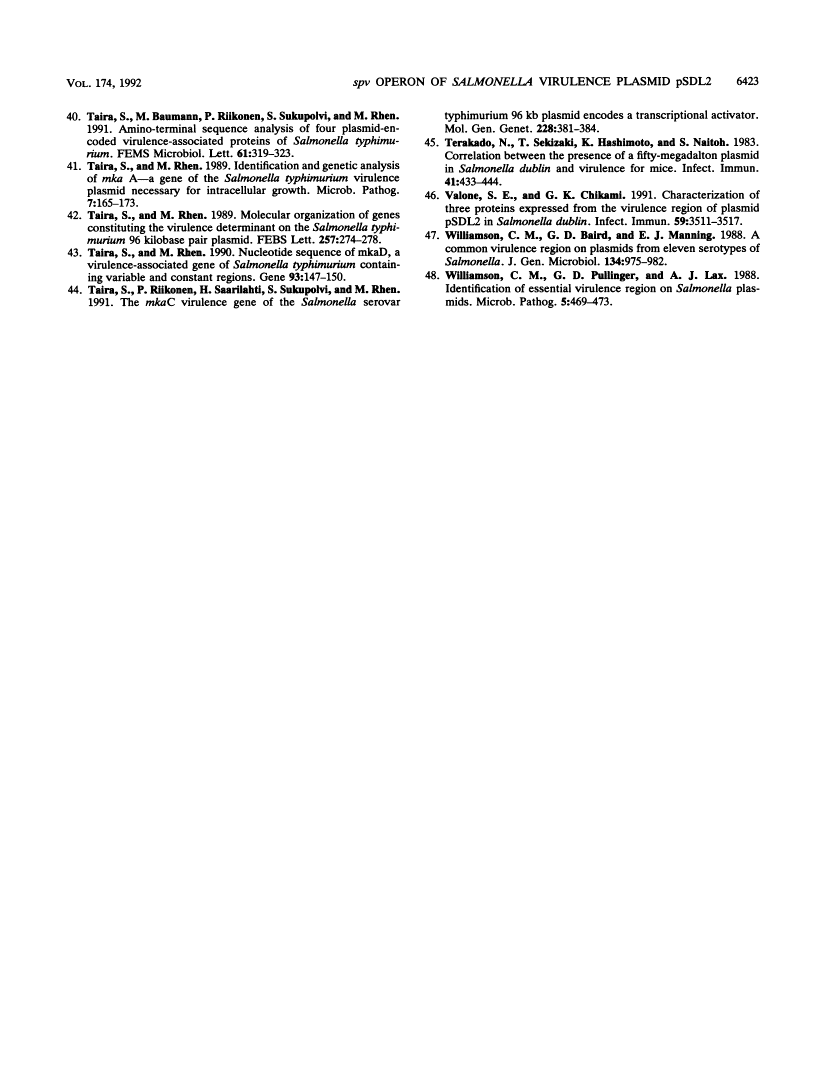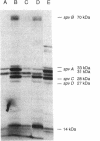Abstract
Free full text

Characterization of translation termination mutations in the spv operon of the Salmonella virulence plasmid pSDL2.
Abstract
The spv region of the Salmonella virulence plasmids consists of five genes located on an 8-kb fragment previously shown to be essential for virulence in mice. Four structural genes, spvABCD, form an operon that is transcriptionally activated by the spvR gene product in the stationary phase of growth. The role of the individual spv genes in the virulence phenotype was tested by isolating translation termination linker insertions in each gene. Analysis of proteins synthesized in minicells identified each of the spvABCD gene products and confirmed the dependence of spv structural gene expression on the SpvR regulatory protein. The oligonucleotide insertions in spvA, -B, and -C were shown to be nonpolar. Virulence testing indicated that the SpvB protein, regulated by SpvR, is essential for Salmonella dublin to cause lethal disease in mice. Inserts in spvC and spvD were unstable in vivo for unknown reasons, but these mutants still killed mice at slightly higher inocula. Abolition of spvA had no effect on virulence in this system.
Full text
Full text is available as a scanned copy of the original print version. Get a printable copy (PDF file) of the complete article (1.2M), or click on a page image below to browse page by page. Links to PubMed are also available for Selected References.
Images in this article
Selected References
These references are in PubMed. This may not be the complete list of references from this article.
- Baird GD, Manning EJ, Jones PW. Evidence for related virulence sequences in plasmids of Salmonella dublin and Salmonella typhimurium. J Gen Microbiol. 1985 Jul;131(7):1815–1823. [Abstract] [Google Scholar]
- Barrow PA, Lovell MA. Functional homology of virulence plasmids in Salmonella gallinarum, S. pullorum, and S. typhimurium. Infect Immun. 1989 Oct;57(10):3136–3141. [Europe PMC free article] [Abstract] [Google Scholar]
- Beninger PR, Chikami G, Tanabe K, Roudier C, Fierer J, Guiney DG. Physical and genetic mapping of the Salmonella dublin virulence plasmid pSDL2. Relationship to plasmids from other Salmonella strains. J Clin Invest. 1988 May;81(5):1341–1347. [Europe PMC free article] [Abstract] [Google Scholar]
- Caldwell AL, Gulig PA. The Salmonella typhimurium virulence plasmid encodes a positive regulator of a plasmid-encoded virulence gene. J Bacteriol. 1991 Nov;173(22):7176–7185. [Europe PMC free article] [Abstract] [Google Scholar]
- Chikami GK, Fierer J, Guiney DG. Plasmid-mediated virulence in Salmonella dublin demonstrated by use of a Tn5-oriT construct. Infect Immun. 1985 Nov;50(2):420–424. [Europe PMC free article] [Abstract] [Google Scholar]
- Fang FC, Krause M, Roudier C, Fierer J, Guiney DG. Growth regulation of a Salmonella plasmid gene essential for virulence. J Bacteriol. 1991 Nov;173(21):6783–6789. [Europe PMC free article] [Abstract] [Google Scholar]
- Gulig PA. Virulence plasmids of Salmonella typhimurium and other salmonellae. Microb Pathog. 1990 Jan;8(1):3–11. [Abstract] [Google Scholar]
- Gulig PA, Chiodo VA. Genetic and DNA sequence analysis of the Salmonella typhimurium virulence plasmid gene encoding the 28,000-molecular-weight protein. Infect Immun. 1990 Aug;58(8):2651–2658. [Europe PMC free article] [Abstract] [Google Scholar]
- Gulig PA, Curtiss R., 3rd Plasmid-associated virulence of Salmonella typhimurium. Infect Immun. 1987 Dec;55(12):2891–2901. [Europe PMC free article] [Abstract] [Google Scholar]
- Gulig PA, Curtiss R., 3rd Cloning and transposon insertion mutagenesis of virulence genes of the 100-kilobase plasmid of Salmonella typhimurium. Infect Immun. 1988 Dec;56(12):3262–3271. [Europe PMC free article] [Abstract] [Google Scholar]
- Heffernan EJ, Fierer J, Chikami G, Guiney D. Natural history of oral Salmonella dublin infection in BALB/c mice: effect of an 80-kilobase-pair plasmid on virulence. J Infect Dis. 1987 Jun;155(6):1254–1259. [Abstract] [Google Scholar]
- Heffron F, So M, McCarthy BJ. In vitro mutagenesis of a circular DNA molecule by using synthetic restriction sites. Proc Natl Acad Sci U S A. 1978 Dec;75(12):6012–6016. [Europe PMC free article] [Abstract] [Google Scholar]
- Henikoff S, Haughn GW, Calvo JM, Wallace JC. A large family of bacterial activator proteins. Proc Natl Acad Sci U S A. 1988 Sep;85(18):6602–6606. [Europe PMC free article] [Abstract] [Google Scholar]
- Hovi M, Sukupolvi S, Edwards MF, Rhen M. Plasmid-associated virulence of Salmonella enteritidis. Microb Pathog. 1988 May;4(5):385–391. [Abstract] [Google Scholar]
- Jones GW, Rabert DK, Svinarich DM, Whitfield HJ. Association of adhesive, invasive, and virulent phenotypes of Salmonella typhimurium with autonomous 60-megadalton plasmids. Infect Immun. 1982 Nov;38(2):476–486. [Europe PMC free article] [Abstract] [Google Scholar]
- Kawahara K, Haraguchi Y, Tsuchimoto M, Terakado N, Danbara H. Evidence of correlation between 50-kilobase plasmid of Salmonella choleraesuis and its virulence. Microb Pathog. 1988 Feb;4(2):155–163. [Abstract] [Google Scholar]
- Kawahara K, Tsuchimoto M, Sudo K, Terakado N, Danbara H. Identification and mapping of mba regions of the Salmonella choleraesuis virulence plasmid pKDSC50 responsible for mouse bacteremia. Microb Pathog. 1990 Jan;8(1):13–21. [Abstract] [Google Scholar]
- Krause M, Fang FC, Guiney DG. Regulation of plasmid virulence gene expression in Salmonella dublin involves an unusual operon structure. J Bacteriol. 1992 Jul;174(13):4482–4489. [Europe PMC free article] [Abstract] [Google Scholar]
- Krause M, Guiney DG. Identification of a multimer resolution system involved in stabilization of the Salmonella dublin virulence plasmid pSDL2. J Bacteriol. 1991 Sep;173(18):5754–5762. [Europe PMC free article] [Abstract] [Google Scholar]
- Krause M, Roudier C, Fierer J, Harwood J, Guiney D. Molecular analysis of the virulence locus of the Salmonella dublin plasmid pSDL2. Mol Microbiol. 1991 Feb;5(2):307–316. [Abstract] [Google Scholar]
- Lax AJ, Pullinger GD, Baird GD, Williamson CM. The virulence plasmid of Salmonella dublin: detailed restriction map and analysis by transposon mutagenesis. J Gen Microbiol. 1990 Jun;136(6):1117–1123. [Abstract] [Google Scholar]
- Michiels T, Popoff MY, Durviaux S, Coynault C, Cornelis G. A new method for the physical and genetic mapping of large plasmids: application to the localisation of the virulence determinants on the 90 kb plasmid of Salmonella typhimurium. Microb Pathog. 1987 Aug;3(2):109–116. [Abstract] [Google Scholar]
- Matsui H, Kawahara K, Terakado N, Danbara H. Nucleotide sequence of a gene encoding a 29 kDa polypeptide in mba region of the virulence plasmid, pKDSC50, of Salmonella choleraesuis. Nucleic Acids Res. 1990 Feb 25;18(4):1055–1055. [Europe PMC free article] [Abstract] [Google Scholar]
- Matsui H, Kawahara K, Terakado N, Danbara H. Nucleotide sequences of genes encoding 32 kDa and 70 kDa polypeptides in mba region of the virulence plasmid, pKDSc50, of Salmonella choleraesuis. Nucleic Acids Res. 1990 Apr 25;18(8):2181–2182. [Europe PMC free article] [Abstract] [Google Scholar]
- Norel F, Coynault C, Miras I, Hermant D, Popoff MY. Cloning and expression of plasmid DNA sequences involved in Salmonella serotype typhimurium virulence. Mol Microbiol. 1989 Jun;3(6):733–743. [Abstract] [Google Scholar]
- Norel F, Pisano MR, Nicoli J, Popoff MY. Nucleotide sequence of the plasmid-borne virulence gene mkfA encoding a 28 kDa polypeptide from Salmonella typhimurium. Res Microbiol. 1989 Mar-Apr;140(3):263–265. [Abstract] [Google Scholar]
- Norel F, Pisano MR, Nicoli J, Popoff MY. Nucleotide sequence of the plasmid-borne virulence gene mkfB from Salmonella typhimurium. Res Microbiol. 1989 Sep;140(7):455–457. [Abstract] [Google Scholar]
- Norel F, Pisano MR, Nicoli J, Popoff MY. A plasmid-borne virulence region (2.8 kb) from Salmonella typhimurium contains two open reading frames. Res Microbiol. 1989 Nov-Dec;140(9):627–630. [Abstract] [Google Scholar]
- Perlman D, Halvorson HO. The MURFI linker for multiple reading frame insertion of a sense or nonsense codon into DNA. Nucleic Acids Res. 1986 Mar 11;14(5):2139–2155. [Europe PMC free article] [Abstract] [Google Scholar]
- Plamann LS, Stauffer GV. Nucleotide sequence of the Salmonella typhimurium metR gene and the metR-metE control region. J Bacteriol. 1987 Sep;169(9):3932–3937. [Europe PMC free article] [Abstract] [Google Scholar]
- Poppe C, Curtiss R, 3rd, Gulig PA, Gyles CL. Hybridization studies with a DNA probe derived from the virulence region of the 60 Mdal plasmid of Salmonella typhimurium. Can J Vet Res. 1989 Oct;53(4):378–384. [Europe PMC free article] [Abstract] [Google Scholar]
- Pullinger GD, Baird GD, Williamson CM, Lax AJ. Nucleotide sequence of a plasmid gene involved in the virulence of salmonellas. Nucleic Acids Res. 1989 Oct 11;17(19):7983–7983. [Europe PMC free article] [Abstract] [Google Scholar]
- Rhen M, Virtanen M, Mäkelä PH. Localization by insertion mutagenesis of a virulence-associated region on the Salmonella typhimurium 96 kilobase pair plasmid. Microb Pathog. 1989 Feb;6(2):153–158. [Abstract] [Google Scholar]
- Roudier C, Krause M, Fierer J, Guiney DG. Correlation between the presence of sequences homologous to the vir region of Salmonella dublin plasmid pSDL2 and the virulence of twenty-two Salmonella serotypes in mice. Infect Immun. 1990 May;58(5):1180–1185. [Europe PMC free article] [Abstract] [Google Scholar]
- Sanger F, Nicklen S, Coulson AR. DNA sequencing with chain-terminating inhibitors. Proc Natl Acad Sci U S A. 1977 Dec;74(12):5463–5467. [Europe PMC free article] [Abstract] [Google Scholar]
- Taira S, Baumann M, Riikonen P, Sukupolvi S, Rhen M. Amino-terminal sequence analysis of four plasmid-encoded virulence-associated proteins of Salmonella typhimurium. FEMS Microbiol Lett. 1991 Jan 15;61(2-3):319–323. [Abstract] [Google Scholar]
- Taira S, Rhen M. Identification and genetic analysis of mkaA--a gene of the Salmonella typhimurium virulence plasmid necessary for intracellular growth. Microb Pathog. 1989 Sep;7(3):165–173. [Abstract] [Google Scholar]
- Taira S, Rhen M. Molecular organization of genes constituting the virulence determinant on the Salmonella typhimurium 96 kilobase pair plasmid. FEBS Lett. 1989 Nov 6;257(2):274–278. [Abstract] [Google Scholar]
- Taira S, Rhen M. Nucleotide sequence of mkaD, a virulence-associated gene of Salmonella typhimurium containing variable and constant regions. Gene. 1990 Sep 1;93(1):147–150. [Abstract] [Google Scholar]
- Taira S, Riikonen P, Saarilahti H, Sukupolvi S, Rhen M. The mkaC virulence gene of the Salmonella serovar typhimurium 96 kb plasmid encodes a transcriptional activator. Mol Gen Genet. 1991 Sep;228(3):381–384. [Abstract] [Google Scholar]
- Terakado N, Sekizaki T, Hashimoto K, Naitoh S. Correlation between the presence of a fifty-megadalton plasmid in Salmonella dublin and virulence for mice. Infect Immun. 1983 Jul;41(1):443–444. [Europe PMC free article] [Abstract] [Google Scholar]
- Valone SE, Chikami GK. Characterization of three proteins expressed from the virulence region of plasmid pSDL2 in Salmonella dublin. Infect Immun. 1991 Oct;59(10):3511–3517. [Europe PMC free article] [Abstract] [Google Scholar]
- Williamson CM, Baird GD, Manning EJ. A common virulence region on plasmids from eleven serotypes of Salmonella. J Gen Microbiol. 1988 Apr;134(4):975–982. [Abstract] [Google Scholar]
- Williamson CM, Pullinger GD, Lax AJ. Identification of an essential virulence region on Salmonella plasmids. Microb Pathog. 1988 Dec;5(6):469–473. [Abstract] [Google Scholar]
Associated Data
Articles from Journal of Bacteriology are provided here courtesy of American Society for Microbiology (ASM)
Full text links
Read article at publisher's site: https://doi.org/10.1128/jb.174.20.6418-6423.1992
Read article for free, from open access legal sources, via Unpaywall:
https://jb.asm.org/content/jb/174/20/6418.full.pdf
Free after 4 months at jb.asm.org
http://jb.asm.org/cgi/reprint/174/20/6418
Free to read at jb.asm.org
http://jb.asm.org/cgi/content/abstract/174/20/6418
Citations & impact
Impact metrics
Citations of article over time
Alternative metrics
Smart citations by scite.ai
Explore citation contexts and check if this article has been
supported or disputed.
https://scite.ai/reports/10.1128/jb.174.20.6418-6423.1992
Article citations
The LysR-Type Transcription Regulator YhjC Promotes the Systemic Infection of Salmonella Typhimurium in Mice.
Int J Mol Sci, 24(2):1302, 09 Jan 2023
Cited by: 0 articles | PMID: 36674819 | PMCID: PMC9867438
CRISPR/Cas9-Based Deletion of SpvB Gene From Salmonella gallinarum Leads to Loss of Virulence in Chicken.
Front Bioeng Biotechnol, 10:885227, 13 Jun 2022
Cited by: 5 articles | PMID: 35769104 | PMCID: PMC9234527
Whole genome sequencing and protein structure analyses of target genes for the detection of Salmonella.
Sci Rep, 11(1):20887, 22 Oct 2021
Cited by: 7 articles | PMID: 34686701 | PMCID: PMC8536731
Systematic reconstruction of an effector-gene network reveals determinants of Salmonella cellular and tissue tropism.
Cell Host Microbe, 29(10):1531-1544.e9, 17 Sep 2021
Cited by: 13 articles | PMID: 34536347 | PMCID: PMC8516738
Identification of Genetic Features for Attenuation of Two Salmonella Enteritidis Vaccine Strains and Differentiation of These From Wildtype Isolates Using Whole Genome Sequencing.
Front Vet Sci, 6:447, 18 Dec 2019
Cited by: 5 articles | PMID: 31921908 | PMCID: PMC6930191
Go to all (40) article citations
Data
Similar Articles
To arrive at the top five similar articles we use a word-weighted algorithm to compare words from the Title and Abstract of each citation.
Regulation of plasmid virulence gene expression in Salmonella dublin involves an unusual operon structure.
J Bacteriol, 174(13):4482-4489, 01 Jul 1992
Cited by: 47 articles | PMID: 1378053 | PMCID: PMC206235
Central regulatory role for the RpoS sigma factor in expression of Salmonella dublin plasmid virulence genes.
J Bacteriol, 177(18):5303-5309, 01 Sep 1995
Cited by: 53 articles | PMID: 7665519 | PMCID: PMC177323
Role of rpoS in the regulation of Salmonella plasmid virulence (spv) genes.
FEMS Microbiol Lett, 123(1-2):125-130, 01 Oct 1994
Cited by: 31 articles | PMID: 7988879
Molecular analysis of spv virulence genes of the Salmonella virulence plasmids.
Mol Microbiol, 7(6):825-830, 01 Mar 1993
Cited by: 189 articles | PMID: 8483415
Review
